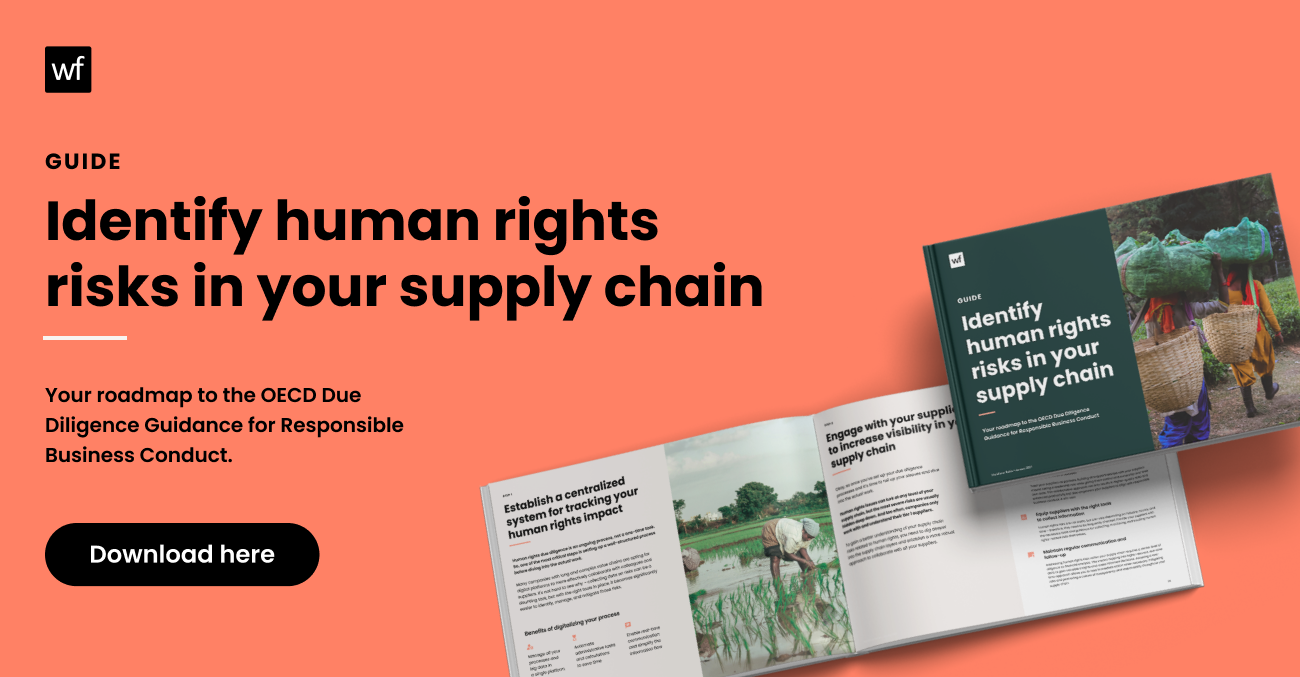The future of human rights: navigating the impacts of AI, climate change, and increased forced labor
How do the climate crisis, artificial intelligence, due diligence regulations, and the significant increase in forced labor impact human rights?
Here's Worldfavor's Senior Sustainability Advisor Ulrika Sandberg's take on it.

Published: May 2023
In a world where human and labor rights are being threatened daily, what role do businesses play in safeguarding them? With governments worldwide introducing mandatory human rights due diligence legislation (the EU is finalizing its own as we speak) it's clear that the answer to that question is a significant one. But now, as we face new paradigm-shifting technologies and the consequences of climate change, businesses are being forced to consider an entirely new set of challenges when it comes to working with and respecting human rights.
To dive deeper into this complex issue, we sat down with Worldfavor's very own Senior Sustainability Advisor Ulrika Sandberg to get her take on which are the key human rights challenges companies will be faced within the near future – and how to best navigate them.
1. The climate crisis: a human rights crisis
The climate crisis we're facing is not just a scientific or political issue – but also a human rights crisis. With each passing year, the world is experiencing more frequent and severe heat waves, flooding of entire cities, devastating hurricanes, and drying up of otherwise rivers and arable farmland.
Groups especially vulnerable to the climate crisis
Unfortunately, the effects of the climate crisis are not distributed equally. In particular, marginalized and vulnerable communities are hit the hardest.
Indigenous communities, who have a traditional way of life close to nature, are among the most marginalized groups and are badly affected by the climate crisis. This is partly due to the increasing demand for certain minerals and metals needed for the transition from fossil fuels to renewable energy sources, and which are often found on indigenous peoples' land in places like Chile and the Philippines.
Therefore, when transitioning to a more sustainable world, we cannot get trapped in the carbon tunnel vision solely focusing on reducing carbon emissions. We most also simultaneously protect and companies must respect human rights.
2. The risks and rewards of technology and rapidly advancing AI
Technology, not to mention Artificial Intelligence, is being developed at a rapidly increasing speed – and with it comes exciting new opportunities. But with progress comes responsibility, and it’s crucial that we consider the potential risks and challenges that come with these innovations.
Technology’s effect on human rights
On the one hand, we’ve seen how the internet and social media platforms have opened up a world of possibilities for protecting and enabling freedom of expression. Even during times of war and political upheaval with internet shutdowns, individuals have been able to connect and communicate with the rest of the world.
On the other hand, the same platforms have also been used to spread hate and discrimination, which have led to cases where social media platform providers are facing trial for being complicit in the violation of human rights.Risks of AI on human rights
The rapid development of advanced AI systems in the past months has got many to wonder: how will it affect humans and our societies as we know them? The launch of the chatbot ChatGPT is a prime example of the rapid development of new technology that can provide immense opportunities – but whose potential negative impact we do not yet fully understand. But since a chatbot doesn’t have the human aspect of consequential thinking, feelings, or values, messages tainted with discriminatory terminology and expressions have already raised ethical concerns.
Minimize these risks
The challenge is now to minimize these risks through international frameworks and regulations that set boundaries of what is acceptable and not, placing responsibility both on the user and the developer. But with technological development advancing so quickly, legislators and actors need to move just as fast to keep up. The EU is already addressing this issue with the draft Artificial Intelligence Act, which includes provisions on ChatGPT and similar chatbots.
3. Due diligence: downstream, upstream, or both?
All around the world, governments are stepping up to protect human rights by implementing human rights due diligence legislations. But exactly how will that affect businesses? With the EU’s proposed Corporate Sustainability Due Diligence directive (CSDDD) expected to be adopted later this year, there’s much debate about what it should look like.
The EU's Corporate Sustainability Due Diligence directive (CSDDD)
Some stakeholders argue that due diligence should exclude the downstream aspect of the value chain, whereas others want it to include it. The OECD Guidelines and the United Nations Guiding Principles on Business and Human Rights, which the CSDDD states it is aligned with, are clear in that a risk-based approach should cover the full value chain, in other words both up- and downstream. In fact, in the fall of 2022, the UN Office of the High Commissioner for Human Rights urged the EU Commission to align the CSDDD with international standards and include both upstream and downstream aspects of business relations.
If the final text of the CSDDD will include both dimensions, companies will need to incorporate human rights impacts on consumers and end-users of products and services, such as online platforms, food and beverage products, weapons, and consumer finance products, into their human rights due diligence risk assessments.
To be fully prepared for the final text of the directive, companies should begin assessing human rights impacts along their entire value chain. This proactive approach will ensure that you’re not caught off-guard or accused of operating unethically and irresponsibly.
4. Forced and child labor on the increase
In May 2022, the United Nations informed that the number of people caught in modern slavery, such as forced and child labor, has been rising over the last few years – reversing the previously positive trend towards elimination.
Forced and child labor is increasing
There is a myriad of reasons for this trend reversal, including the effects of the covid-19 pandemic, but one thing is clear: businesses need to be more diligent in their efforts to combat these risks, especially far out in their supply and value chains where human rights abuse such as forced and child labor most often occur.
How to break this development
The international community is working hard to put an end to forced and child labor. At the international level, multi-stakeholder initiatives are being implemented, and international conventions are holding states legally accountable for putting in place processes for eradicating forced and child labor. Plus, the EU is drafting a forced labor regulation that will legally require companies to take action on these human and labor rights risks.
And it’s not just the EU. More and more countries are taking legislative action. Mexico recently introduced a forced labor regulation, while Canada’s proposal for a forced and child labor in supply chain law is in its the final approval stages.
This is why it is important that you as a company investigate how these salient human and labor rights risks and forthcoming regulations can impact your business today and in the future. Don’t wait until it’s too late – take action now to ensure your company’s success and reputation tomorrow!
Get started with your human rights due diligence with Worldfavor
Detect human rights risks, identify pitfalls, and take action to minimize negative impact in your supply chain. Join Worldfavor to systemize and automize your OECD-aligned risk assessment. Want to know how? Let’s talk!
Related blog post you might like:






%20as%20the%20deadline%20approaches.%20Learn%20about%20compliance%20requirements%2c%20potential%20delays%2c%20and%20key%20updates..png)

